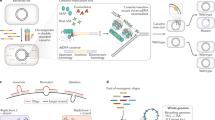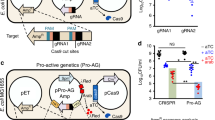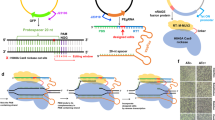Abstract
Whereas bacterial artificial chromosomes (BACs) offer many advantages in studies of gene and protein function, generation of seamless, precisely mutated BACs has been difficult. Here we describe a counterselection-based recombineering method and its accompanying reagents. After identifying intramolecular recombination as the major problem in counterselection, we built a strategy to reduce these unwanted events by expressing Redβ alone at the crucial step. We enhanced this method by using phosphothioated oligonucleotides, using a sequence-altered rpsL counterselection gene and developing online software for oligonucleotide design. We illustrated this method by generating transgenic mammalian cell lines carrying small interfering RNA–resistant and point-mutated BAC transgenes. Using this approach, we generated mutated TACC3 transgenes to identify phosphorylation-specific spindle defects after knockdown of endogenous TACC3 expression. Our results highlight the complementary use of precisely mutated BAC transgenes and RNA interference in the study of cell biology at physiological expression levels and regulation.
This is a preview of subscription content, access via your institution
Access options
Subscribe to this journal
Receive 12 print issues and online access
$259.00 per year
only $21.58 per issue
Buy this article
- Purchase on Springer Link
- Instant access to full article PDF
Prices may be subject to local taxes which are calculated during checkout




Similar content being viewed by others
References
Zhang, Y., Buchholz, F., Muyrers, J.P. & Stewart, A.F. A new logic for DNA engineering using recombination in Escherichia coli. Nat. Genet. 20, 123–128 (1998).
Muyrers, J.P., Zhang, Y., Testa, G. & Stewart, A.F. Rapid modification of bacterial artificial chromosomes by ET-recombination. Nucleic Acids Res. 27, 1555–1557 (1999).
Copeland, N.G., Jenkins, N.A. & Court, D.L. Recombineering: a powerful new tool for mouse functional genomics. Nat. Rev. Genet. 2, 769–779 (2001).
Testa, G. et al. Engineering the mouse genome with bacterial artificial chromosomes to create multipurpose alleles. Nat. Biotechnol. 21, 443–447 (2003).
Kittler, R. et al. RNA interference rescue by bacterial artificial chromosome transgenesis in mammalian tissue culture cells. Proc. Natl. Acad. Sci. USA 102, 2396–2401 (2005).
Hofemeister, H. et al. Recombineering, transfection, Western, IP and ChIP methods for protein tagging via gene targeting or BAC transgenesis. Methods 53, 437–452 (2011).
Sarov, M. et al. A recombineering pipeline for functional genomics applied to Caenorhabditis elegans. Nat. Methods 3, 839–844 (2006).
Poser, I. et al. BAC TransgeneOmics: a high-throughput method for exploration of protein function in mammals. Nat. Methods 5, 409–415 (2008).
Skarnes, W.C. et al. A conditional knockout resource for the genome-wide study of mouse gene function. Nature 474, 337–342 (2011).
Bird, A.W. & Hyman, A.A. Building a spindle of the correct length in human cells requires the interaction between TPX2 and Aurora A. J. Cell Biol. 182, 289–300 (2008).
Hubner, N.C. et al. Quantitative proteomics combined with BAC TransgeneOmics reveals in vivo protein interactions. J. Cell Biol. 189, 739–754 (2010).
Muyrers, J.P. et al. Point mutation of bacterial artificial chromosomes by ET recombination. EMBO Rep. 1, 239–243 (2000).
Warming, S., Costantino, N., Court, D.L., Jenkins, N.A. & Copeland, N.G. Simple and highly efficient BAC recombineering using galK selection. Nucleic Acids Res. 33, e36 (2005).
Zhang, Y., Muyrers, J.P., Rientjes, J. & Stewart, A.F. Phage annealing proteins promote oligonucleotide-directed mutagenesis in Escherichia coli and mouse ES cells. BMC Mol. Biol. 4, 1 (2003).
Wang, J. et al. An improved recombineering approach by adding RecA to λ Red recombination. Mol. Biotechnol. 32, 43–53 (2006).
Russell, C.B. & Dahlquist, F.W. Exchange of chromosomal and plasmid alleles in Escherichia coli by selection for loss of a dominant antibiotic sensitivity marker. J. Bacteriol. 171, 2614–2618 (1989).
Wang, S., Zhao, Y., Leiby, M. & Zhu, J. A new positive/negative selection scheme for precise BAC recombineering. Mol. Biotechnol. 42, 110–116 (2009).
Westenberg, M., Soedling, H.M., Mann, D.A., Nicholson, L.J. & Dolphin, C.T. Counter-selection recombineering of the baculovirus genome: a strategy for seamless modification of repeat-containing BACs. Nucleic Acids Res. 38, e166 (2010).
Court, R., Cook, N., Saikrishnan, K. & Wigley, D. The crystal structure of λ-Gam protein suggests a model for RecBCD inhibition. J. Mol. Biol. 371, 25–33 (2007).
Murphy, K.C. The λ Gam protein inhibits RecBCD binding to dsDNA ends. J. Mol. Biol. 371, 19–24 (2007).
Erler, A. et al. Conformational adaptability of Redβ during DNA annealing and implications for its structural relationship with Rad52. J. Mol. Biol. 391, 586–598 (2009).
Kovall, R. & Matthews, B.W. Toroidal structure of λ-exonuclease. Science 277, 1824–1827 (1997).
Wu, Z. et al. Domain structure and DNA binding regions of (protein from bacteriophage λ. J. Biol. Chem. 281, 25205–25214 (2006).
Maresca, M. et al. Single-stranded heteroduplex intermediates in λ Red homologous recombination. BMC Mol. Biol. 11, 54 (2010).
Mosberg, J.A., Lajoie, M.J. & Church, G.M. λ red recombineering in Escherichia coli occurs through a fully single-stranded intermediate. Genetics 186, 791–799 (2010).
Ellis, H.M., Yu, D., DiTizio, T. & Court, D.L. High efficiency mutagenesis, repair, and engineering of chromosomal DNA using single-stranded oligonucleotides. Proc. Natl. Acad. Sci. USA 98, 6742–6746 (2001).
Stahl, M.M. et al. Annealing vs. invasion in phage λ recombination. Genetics 147, 961–977 (1997).
Anastassiadis, K. et al. Dre recombinase, like Cre, is a highly efficient site-specific recombinase in E. coli, mammalian cells and mice. Dis. Model. Mech. 2, 508–515 (2009).
Muyrers, J.P., Zhang, Y., Buchholz, F. & Stewart, A.F. RecE/RecT and Redα/Redβ initiate double-stranded break repair by specifically interacting with their respective partners. Genes Dev. 14, 1971–1982 (2000).
Peset, I. & Vernos, I. The TACC proteins: TACC-ling microtubule dynamics and centrosome function. Trends Cell Biol. 18, 379–388 (2008).
Giet, R. et al. Drosophila Aurora A kinase is required to localize D-TACC to centrosomes and to regulate astral microtubules. J. Cell Biol. 156, 437–451 (2002).
Kinoshita, K. Aurora A phosphorylation of TACC3/maskin is required for centrosome-dependent microtubule assembly in mitosis. J. Cell Biol. 170, 1047–1055 (2005).
Fu, W. et al. Clathrin recruits phosphorylated TACC3 to spindle poles for bipolar spindle assembly and chromosome alignment. J. Cell Sci. 123, 3645–3651 (2010).
Royle, S.J., Bright, N.A. & Lagnado, L. Clathrin is required for the function of the mitotic spindle. Nature 434, 1152–1157 (2005).
Acknowledgements
A.W.B. is supported by a Max Planck Society Fellowship. The research leading to these results received funding from the European Community's Seventh Framework Programmes (FP7/2007-2013) MITOSYS (Systems Biology of Mitosis) (grant number 241548), EUCOMMTOOLS (EUCOMM: Tools for Functional Annotation of the Mouse Genome) (grant number 254221) and SyBoSS (Systems Biology of Stem Cells and Reprogramming) (grant number 253422).
Author information
Authors and Affiliations
Contributions
A.W.B. designed experiments, performed experiments and prepared the manuscript. A.E., J.F. and M.M. designed experiments and performed experiments. J.-K.H. developed BACFinder2.0. Y.Z. and A.A.H. designed experiments. A.F.S. designed experiments and prepared the manuscript.
Corresponding authors
Ethics declarations
Competing interests
Y.Z. and A.F.S. are shareholders in Gene Bridges GmbH, which holds the patent rights to the primary recombineering methodologies upon which this study is based.
Supplementary information
Supplementary Text and Figures
Supplementary Figures 1–3, Supplementary Table 1 and Supplementary Protocols 1 and 2. (PDF 3123 kb)
Rights and permissions
About this article
Cite this article
Bird, A., Erler, A., Fu, J. et al. High-efficiency counterselection recombineering for site-directed mutagenesis in bacterial artificial chromosomes. Nat Methods 9, 103–109 (2012). https://doi.org/10.1038/nmeth.1803
Received:
Accepted:
Published:
Issue Date:
DOI: https://doi.org/10.1038/nmeth.1803
This article is cited by
-
High production of fatty alcohols in Escherichia coli with fatty acid starvation
Microbial Cell Factories (2016)
-
Repetitive genomic insertion of gene-sized dsDNAs by targeting the promoter region of a counter-selectable marker
Scientific Reports (2015)
-
Isolation of rare recombinants without using selectable markers for one-step seamless BAC mutagenesis
Nature Methods (2014)
-
A genomic toolkit to investigate kinesin and myosin motor function in cells
Nature Cell Biology (2013)



